In today’s digital landscape, consumers are inundated with marketing messages from every direction. To stand out and truly connect with your audience, one-to-one marketing has emerged as a powerful approach. By tailoring your marketing efforts to individual customers, you can foster deeper relationships, increase engagement, and ultimately drive better results for your business. This comprehensive guide explores the significance of one-to-one marketing, unveils hidden gem strategies to enhance its effectiveness, and highlights how Prism Reach, an innovative AI-powered SaaS solution, can elevate your personalized marketing efforts.
Key Facts and Statistics
Understanding the impact of one-to-one marketing is supported by compelling statistics:
- Customer Engagement: Personalized marketing can increase customer engagement by up to 50%.
- Conversion Rates: One-to-one marketing can boost conversion rates by as much as 202%.
- Customer Satisfaction: 80% of consumers are more likely to make a purchase when brands offer personalized experiences.
- Revenue Growth: Personalized marketing strategies can drive a 15-20% increase in revenue.
- Customer Retention: Personalized experiences can improve customer retention rates by up to 5%, resulting in an increase in profits by 25% to 95%.
Upgrade Your Email Marketing with AI Personalization!
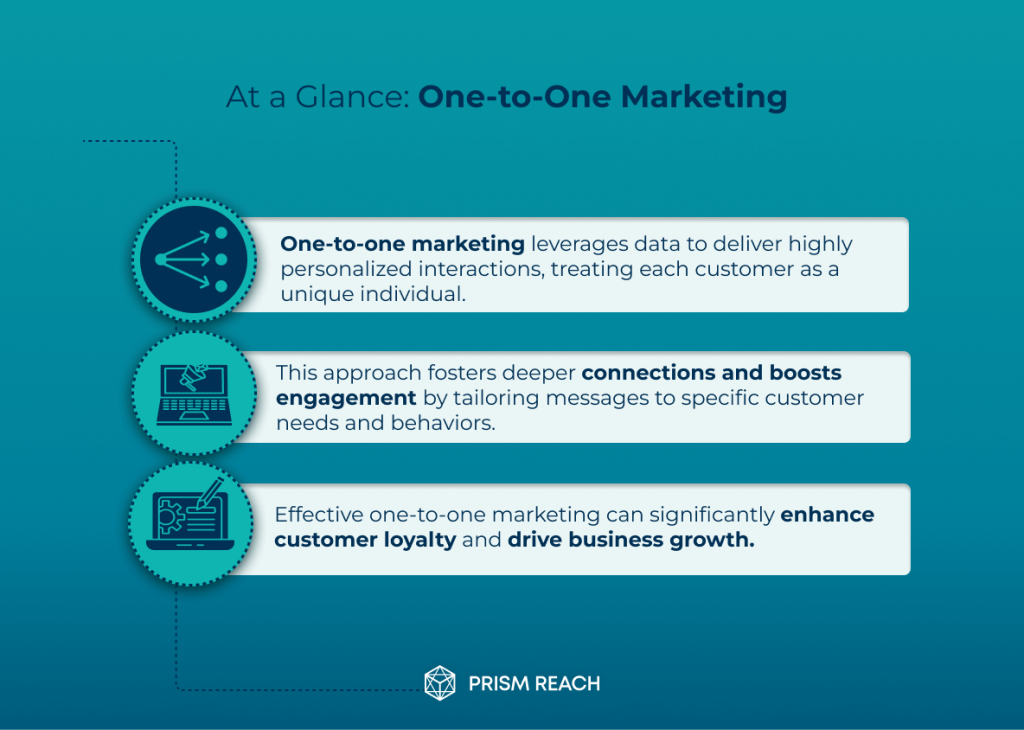
Understanding One-to-One Marketing
One-to-one marketing, also known as personalized marketing, is a strategy that focuses on delivering highly targeted and customized experiences to individual customers. It involves leveraging data and technology to understand each customer’s unique preferences, behaviors, and needs, and then crafting personalized interactions that resonate with them on a deeper level.
What is One-to-One Marketing?
At its core, one-to-one marketing is about treating each customer as a distinct individual rather than a part of a broad segment. It recognizes that every customer has their own unique journey, and by tailoring marketing efforts to their specific needs and interests, businesses can create more meaningful and impactful connections.
Why is One-to-One Marketing Important?
The rise of one-to-one marketing can be attributed to the increasing availability of customer data and the advancement of technologies that enable personalization at scale. With the proliferation of digital channels and the growing expectation for personalized experiences, one-to-one marketing has become a critical strategy for businesses looking to stay competitive and build lasting customer relationships.
- Enhanced Engagement: Personalized messages resonate more with customers, leading to higher engagement rates.
- Increased Loyalty: Tailored experiences foster a stronger emotional connection, increasing customer loyalty.
- Higher Conversion Rates: Relevant and timely offers are more likely to convert leads into customers.
- Improved ROI: Targeted marketing efforts lead to more efficient use of resources and better return on investment.
Comparison: One-to-One Marketing
1. Personalized Email Campaigns
- Advantages:
- Higher Open Rates & Improved Click-Through Rates: Tailored messages increase the likelihood of recipients engaging with emails.
- Increased Conversion Rates: Content that aligns with customer interests drives more sales.
- Stronger Customer Relationships: Personalization builds trust and loyalty over time.
- Better ROI: Efficient targeting leads to a more effective use of marketing budgets.
- Disadvantages:
- Complex Data Management: Requires extensive collection and analysis of customer data.
- Privacy Concerns: Handling personalized data can raise issues related to data protection and consumer trust.
2. Real-Time Website Personalization
- Advantages:
- Enhanced User Experience: Content dynamically adapts to individual visitor preferences.
- Increased Engagement & Higher Conversion Rates: Relevant, real-time offers guide users toward making a purchase.
- Reduced Bounce Rates: Tailored content helps keep visitors on the site longer.
- Dynamic Content Adaptation: The website can change its messaging in response to real-time data.
- Disadvantages:
- High Implementation Costs: Advanced technology and resources are required for real-time personalization.
- Technical Challenges: Integrating dynamic personalization with existing systems can be complex.
3. Targeted Social Media Advertising
- Advantages:
- Precise Audience Targeting: Ads are delivered based on specific demographic or behavioral criteria.
- Increased Ad Relevance & Better Performance: Personalized ads tend to resonate more, leading to higher engagement and conversion rates.
- Efficient Budget Use: Focuses ad spend on users more likely to convert.
- Expanded Reach with Lookalike Audiences: Targets users who share characteristics with existing customers.
- Disadvantages:
- Potential Ad Fatigue: Over-targeting may annoy users and diminish ad effectiveness.
- Complex Campaign Management: Constant monitoring and adjustments are needed to maintain optimal performance.
4. Personalized Product Recommendations
- Advantages:
- Boosted Cross-Selling Opportunities: Offers relevant complementary products to increase average order value.
- Improved Customer Satisfaction & Repeat Purchases: Recommendations align with customer preferences and enhance the shopping experience.
- Enhanced Shopping Experience: Creates a more intuitive, tailored browsing experience.
- Disadvantages:
- Algorithm Dependency: The effectiveness is highly reliant on the accuracy and quality of data.
- Initial Setup Complexity: Requires advanced machine learning integration to start delivering meaningful recommendations.
5. Customized Landing Pages
- Advantages:
- Higher Conversion Rates: Tailored pages that match visitor interests drive more effective calls-to-action.
- Better User Engagement: Customized content captures and retains visitor attention.
- Improved Campaign Performance: Creating specific pages for different audience segments enhances overall results.
- Personalized User Journey: Guides visitors more effectively through the conversion funnel.
- Enhanced A/B Testing: It becomes easier to test and optimize specific elements on these pages.
- Disadvantages:
- Resource Intensive: Creating and managing multiple page variations demands significant effort.
- Complex Management: Continuous updating is required to keep landing pages relevant and effective.
This comparison highlights that while each personalization tactic can significantly enhance user engagement and drive conversions, they also come with technical and operational challenges. The right strategy often depends on balancing these benefits against the resources and expertise available.
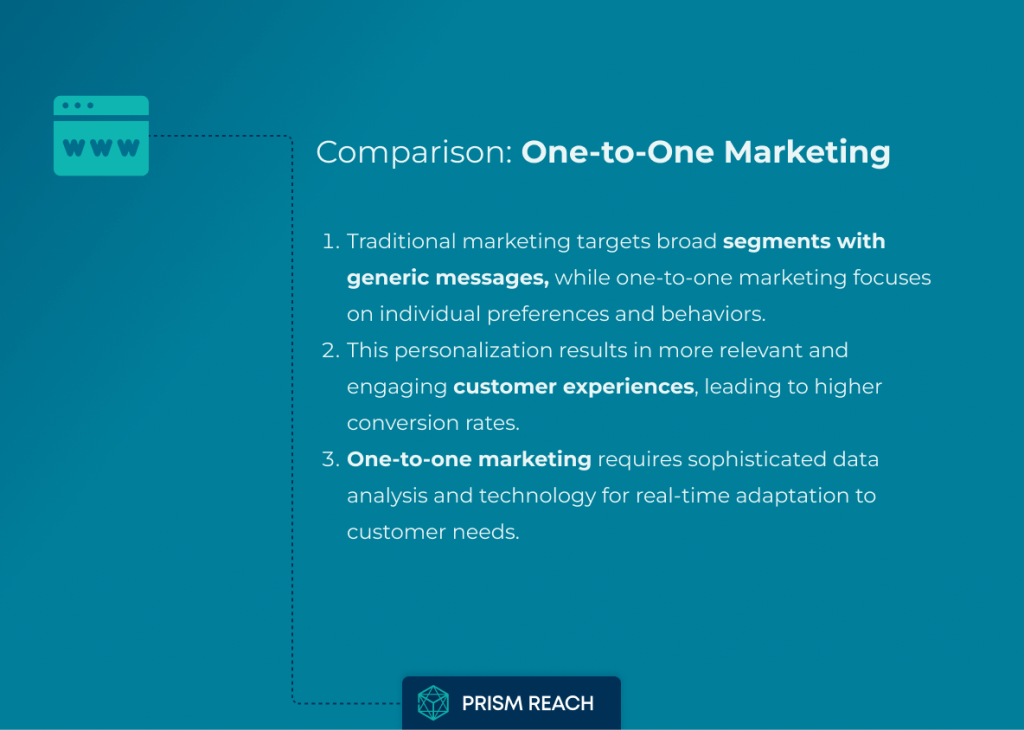
5 Hidden Gem Strategies to Enhance One-to-One Marketing
Maximizing the impact of one-to-one marketing requires innovative strategies that go beyond conventional approaches. Here are five hidden gem strategies that can significantly enhance your marketing effectiveness:
Leverage Zero-Party Data
Strategy: Encourage customers to share their preferences and interests directly through surveys, quizzes, or preference centers, creating zero-party data that can inform personalized marketing efforts.
- Effectiveness: High; zero-party data leads to more accurate personalization since it is explicitly provided by customers.
- Obscurity: Many brands rely on inferred data rather than engaging customers for insights.
- Ease of Implementation: Simple to implement through interactive forms or surveys.
- Uniqueness: Focuses on customer-driven insights, enhancing trust and engagement.
Example: An online bookstore uses Prism Reach to create engaging quizzes that gather readers’ favorite genres and authors. This zero-party data allows the bookstore to send highly personalized book recommendations and tailored promotional offers, resulting in increased open rates and sales.
Implement Predictive Analytics
Strategy: Use predictive analytics to forecast customer behavior based on historical data, allowing for proactive engagement strategies.
- Effectiveness: Extremely high; predictive models can identify high-value customers and those at risk of churn.
- Obscurity: Many businesses calculate Customer Lifetime Value (CLV) without leveraging predictive insights.
- Ease of Implementation: Requires access to data analytics tools but is increasingly feasible with modern software solutions.
- Uniqueness: This strategy focuses on anticipating customer needs rather than reacting to them.
Example: A subscription-based service uses Prism Reach’s predictive analytics to identify customers who are likely to cancel their subscriptions. By proactively reaching out with personalized offers and support, the company successfully reduces churn rates and increases customer retention.
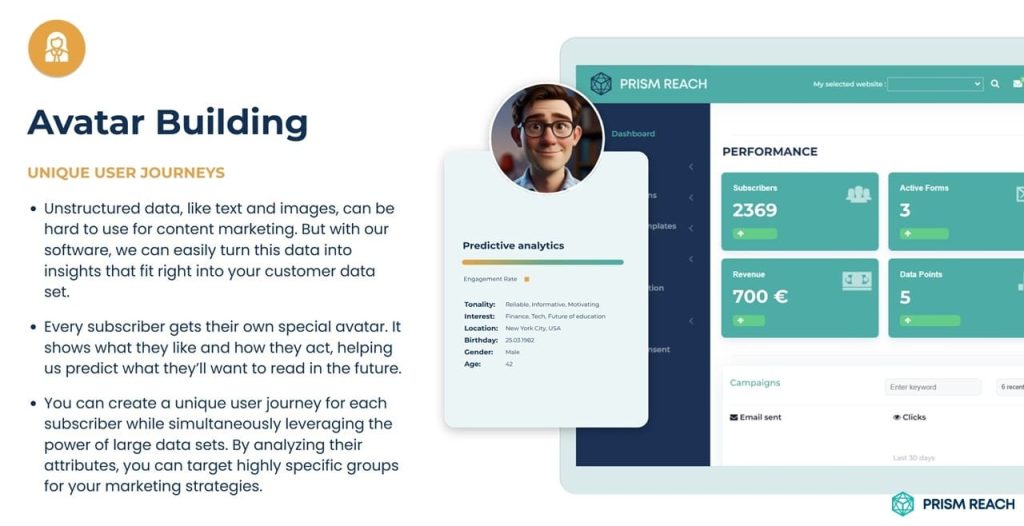
Create Dynamic Content
Strategy: Utilize dynamic content in emails and websites that changes based on user behavior and preferences.
- Effectiveness: Dynamic content can significantly increase engagement rates as it ensures relevance for each recipient.
- Obscurity: Many marketers still use static content without exploring the benefits of dynamic options.
- Ease of Implementation: Most email marketing platforms support dynamic content; requires some setup but manageable with existing tools.
- Uniqueness: This approach allows for highly personalized communication without creating multiple versions of an email or webpage.
Example: A health and wellness brand uses Prism Reach to create interactive quizzes that help users identify their fitness goals. Based on quiz results, the brand sends personalized workout plans and product recommendations, enhancing user engagement and driving sales.
Utilize AI for Hyper-Personalization
Strategy: Implement AI algorithms to analyze customer behavior and deliver hyper-personalized content in real-time across various channels.
- Effectiveness: Extremely high; AI can process vast amounts of data quickly, delivering timely and relevant personalization at scale.
- Obscurity: While AI usage is growing, its application specifically for hyper-personalization remains underutilized.
- Ease of Implementation: Requires investment in AI tools but offers significant long-term benefits once integrated.
- Uniqueness: This approach takes personalization to an advanced level not commonly practiced.
Example: A fashion retailer integrates Prism Reach’s AI capabilities to analyze customer browsing and purchase history. The AI delivers real-time personalized product recommendations on the website and in email campaigns, enhancing the shopping experience and increasing conversion rates.
Create Personalized Loyalty Programs
Strategy: Develop loyalty programs that offer personalized rewards based on individual purchase history and preferences.
- Effectiveness: Personalized rewards increase engagement and spending among loyal customers, boosting CLV.
- Obscurity: Many loyalty programs are generic; tailoring them increases their effectiveness significantly.
- Ease of Implementation: Requires data analysis but can be integrated into existing loyalty frameworks easily.
- Uniqueness: This approach ensures that rewards resonate with individual customers rather than offering a one-size-fits-all solution.
Example: A coffee shop chain uses Prism Reach to analyze customers’ purchase history and preferences. The loyalty program offers personalized rewards such as discounts on favorite beverages, exclusive access to new menu items, and birthday treats, enhancing customer satisfaction and loyalty.
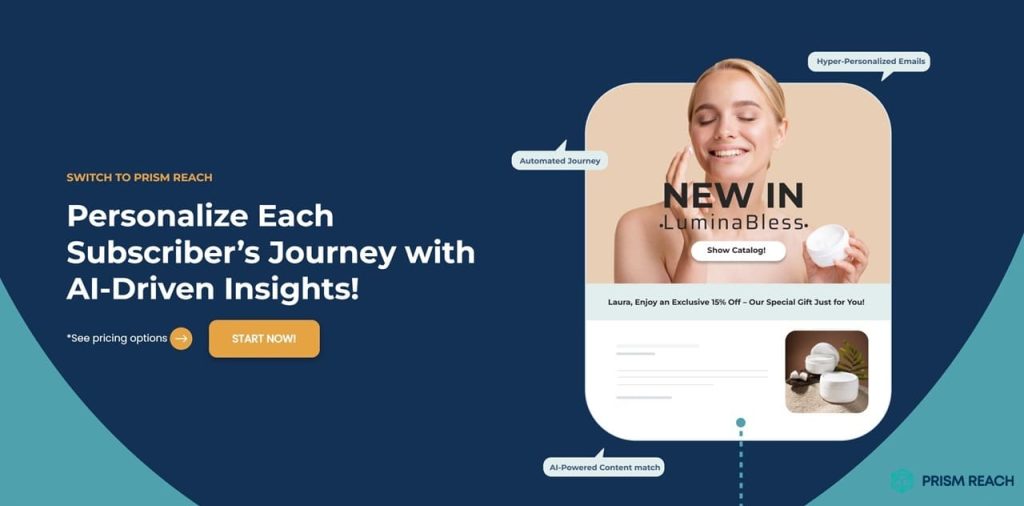
Benefits of Using Prism Reach in One-to-One Marketing
Integrating advanced tools like Prism Reach into your one-to-one marketing strategies can significantly amplify their effectiveness. Prism Reach offers a suite of features specifically designed to enhance personalization, streamline campaign management, and provide actionable insights that drive better marketing outcomes. Here are three key benefits of using Prism Reach in one-to-one marketing:
1. Enhanced Personalization Through AI
Prism Reach utilizes sophisticated AI algorithms to create detailed user avatars based on subscriber behavior and preferences. This level of personalization is crucial for effectively reaching and engaging diverse audiences.
- Tailored Content: AI-driven personalization ensures that each subscriber receives content that is relevant to their unique preferences and interests.
- Behavioral Insights: By analyzing patterns in subscriber behavior, Prism Reach can predict future actions and tailor marketing messages accordingly, increasing the likelihood of positive engagement.
- Cultural Sensitivity: Personalized content respects and reflects the cultural nuances of different demographic groups, fostering a deeper connection with diverse audiences.
Example: A global apparel brand uses Prism Reach to segment its email list based on cultural preferences and purchase history. The AI personalizes each email with culturally relevant product recommendations and messaging, resulting in higher open and conversion rates across diverse markets.
2. Dynamic Content Selection Tailored to Diverse Audiences
Prism Reach’s ability to dynamically select and tailor content based on real-time data ensures that your emails remain relevant and engaging to a diverse audience.
- Real-Time Adaptation: The platform continuously updates content based on the latest subscriber interactions and feedback, keeping your campaigns fresh and responsive to changing preferences.
- Localized Content: Prism Reach can automatically adjust content to align with local cultural events, holidays, and trends, enhancing the relevance of your marketing messages.
- Inclusive Messaging: Dynamic content ensures that marketing messages are inclusive and considerate of diverse perspectives, avoiding one-size-fits-all approaches.
Example: An international food brand leverages Prism Reach to customize its email content based on regional dietary preferences and cultural festivities. During Ramadan, the platform automatically highlights products and recipes that cater to fasting practices, increasing engagement and sales in Muslim-majority regions.
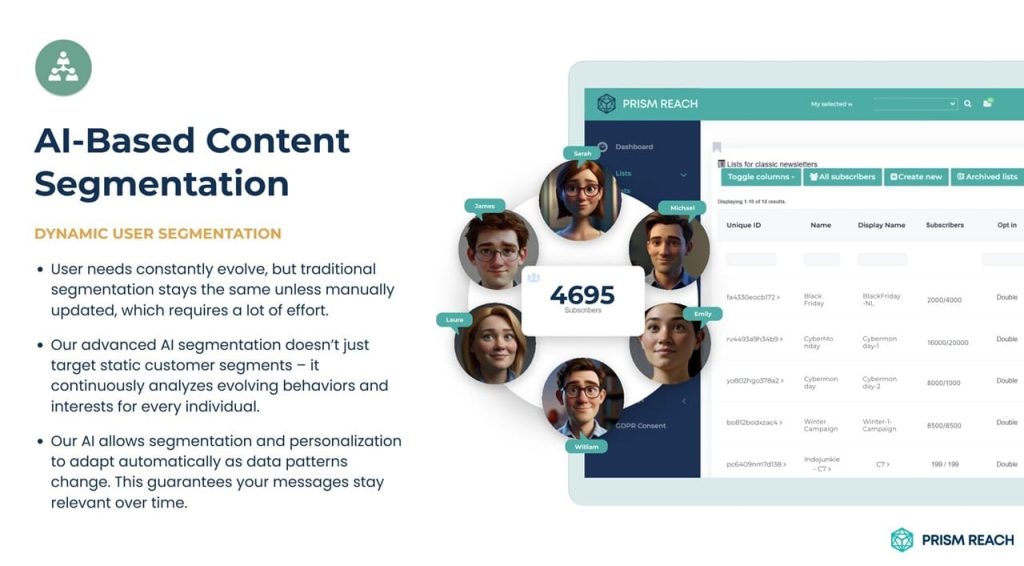
3. Comprehensive Performance Monitoring for Inclusive Campaigns
Prism Reach provides robust tracking tools to monitor the effectiveness of your email campaigns, ensuring that your one-to-one marketing strategies are yielding the desired results.
- Demographic Analytics: The platform offers detailed insights into how different demographic segments are interacting with your campaigns, allowing for data-driven adjustments to improve effectiveness.
- Engagement Metrics: Track key performance indicators such as open rates, click-through rates, and conversion rates across diverse groups to identify what resonates most with each segment.
- Feedback Integration: Prism Reach can incorporate direct feedback from subscribers to refine and enhance your marketing strategies continuously, ensuring ongoing alignment with diverse audience needs.
Example: A multinational electronics company uses Prism Reach to analyze engagement metrics from its diverse customer base. Insights reveal that certain product categories perform better with specific demographic groups, allowing the company to tailor future campaigns to highlight these products more prominently within those segments, thereby maximizing relevance and impact.
Practical Tips for Enhancing One-to-One Marketing in Email Marketing
To effectively enhance one-to-one marketing in your email marketing efforts, consider the following practical tips. These strategies will help ensure that your campaigns are inclusive, culturally sensitive, and highly engaging for a diverse audience:
1. Personalization Techniques
- Use Subscriber Data to Personalize Content: Leverage demographic and behavioral data to create personalized subject lines and email content that reflect the unique backgrounds and interests of your subscribers.
- Segment Your Audience: Divide your email list into segments based on factors such as ethnicity, gender, age, and cultural preferences. This allows for more targeted and relevant messaging.
- Implement Dynamic Content Blocks: Use dynamic content blocks that adapt to individual subscriber interests, ensuring that each email delivers content that is meaningful and engaging to the recipient.
Example: A global travel agency uses Prism Reach to segment its email list by region and cultural preferences. Personalized emails include travel packages that cater to specific cultural festivals and holidays, increasing relevance and engagement among diverse subscribers.
2. Automation Best Practices
- Set Up Automated Workflows: Create automated email workflows that include welcome series, cultural event greetings, and post-purchase follow-ups tailored to different demographic groups.
- Optimize Send Times: Use predictive analytics to determine the best times to send emails to different segments, considering factors such as time zones and cultural schedules.
- Automate Cross-Selling and Upselling: Develop automated campaigns that recommend products based on customer behavior and preferences, ensuring that recommendations are culturally relevant and personalized.
Example: An online bookstore employs Prism Reach to automate personalized recommendations based on customers’ previous purchases and cultural interests. During Diwali, the system sends automated emails featuring books by South Asian authors, enhancing relevance and boosting sales in that segment.
3. Continuous Improvement and Adaptation
- Analyze Campaign Performance: Regularly review performance metrics across different demographic segments to identify what works and what needs improvement.
- Gather and Integrate Customer Feedback: Use surveys, polls, and direct feedback to understand the preferences and experiences of your diverse audience, and adjust your strategies accordingly.
- Stay Updated with Trends and Technologies: Keep abreast of the latest email marketing trends and technologies that support inclusivity and personalization, ensuring your campaigns remain effective and relevant.
Example: A fitness brand uses Prism Reach to continuously monitor the performance of its diverse email campaigns. Feedback collected through integrated surveys reveals a high demand for workout plans tailored to different cultural practices, prompting the brand to develop and promote culturally specific fitness programs.
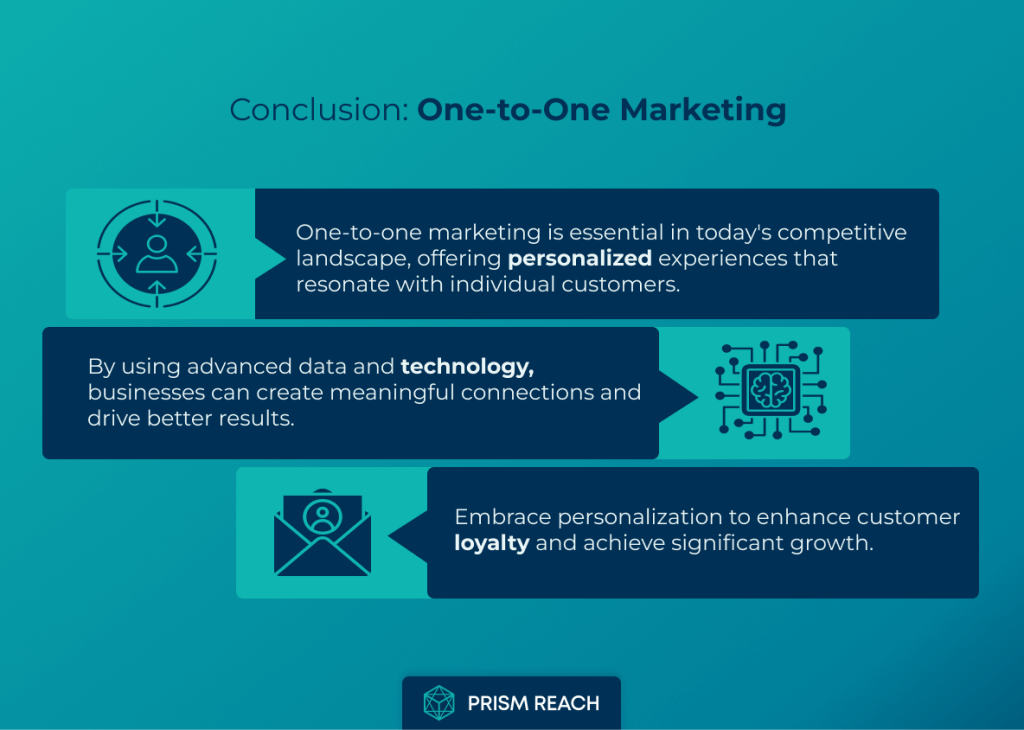
Conclusion
One-to-one marketing has become a critical component of modern marketing strategies. By leveraging customer data, advanced technologies, and personalized approaches, businesses can create more relevant and impactful experiences that resonate deeply with their target audiences. The five hidden gem strategies outlined above—Leverage Zero-Party Data, Implement Predictive Analytics, Create Dynamic Content, Utilize AI for Hyper-Personalization, and Create Personalized Loyalty Programs—provide a comprehensive framework for maximizing the impact of one-to-one marketing.
Integrating advanced tools like Prism Reach further amplifies these strategies by providing enhanced personalization through AI, dynamic content selection tailored to diverse audiences, and comprehensive performance monitoring for inclusive campaigns. Prism Reach empowers businesses to create highly personalized and culturally relevant email marketing experiences that resonate with individual subscribers, leading to higher engagement, loyalty, and revenue growth.
As businesses navigate the complexities of marketing in a diverse world, prioritizing inclusivity and leveraging the right tools and strategies will be key to achieving sustained success. Embrace the power of one-to-one marketing to create a customer-centric approach that drives engagement, loyalty, and sustained revenue growth.
Sources
- ActiveCampaign: One-to-One Marketing
- Mediatool: One-to-One Marketing
- Wunderkind: One-to-One Marketing Strategies
- Adobe: One-to-One Marketing Insights
- Digital Coach: One-to-One Marketing Techniques